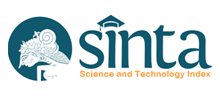Keywords
Teens, Digital Natives, Digital Hoax
Document Type
Article
Abstract
The phenomenon of hoax and hate speech dissemination that occurs in the digital world
has brought anxiety and concern in the community. Many of the hoax information
distributed by Social Media and Instant Messaging tend to be SARA, provocative and
bombastic. Ironically, not a few people who without thinking directly spread information
and even reproduce the information without thinking about the impact caused after.
Digital media is currently dominated by teenagers born in the millennium era and is a
"digital natives" that is a generation that cannot be separated by the digital world. If this
generation is not given enough ammunition to combat digital hoax, then it is feared will
cause latent problems and dangers. In response to this, UIN Sunan Kalijaga Yogyakarta
UI Campaign conducted an anti-hoax campaign with the target of the participants
being teenagers packed through ADUIN Fest 2017 "Nyepik Becik" (Think What You Say)
"on 17-18 May 2017. The approach method was participatory with Directly practicing it
through the creation of creative works in the form of Print-Ad, TVC and short films by
competing participants. Then held creative seminars, exhibition works, Sharing Session
and Awarding Night. It is hoped that the nation's future young generation will be smart,
critical and gain a good understanding so that it can combat digital hoax that can
threaten the unity and unity of the nation.
Fenomena penyebaran hoax dan hate speech yang terjadi di dunia digital telah membawa kecemasan dan keprihatinan di dalam masyarakat. Banyak informasi hoax, hatespeech dan cyberbullying yang disebarkan oknum melalui Social Media dan Instant Messaging yang cenderung berbau SARA, provokatif dan bombastis. Ironisnya tidak sedikit pula masyarakat yang tanpa berpikir panjang langsung menshare informasi tersebut bahkan mereproduksi ulang informasi tanpa memikirkan dampak yang ditimbulkan setelahnya. Media digital saat ini didominasi oleh remaja yang lahir di zaman millennium yang merupakan "digital natives" yaitu generasi yang tidak dapat terpisahkan oleh dunia digital. Jika generasi ini tidak diberikan amunisi yang cukup untuk memerangi digital hoax, maka dikhawatirkan akan menimbulkan masalah dan bahaya laten. Menyikapi hal ini Prodi Ilkom UIN Sunan Kalijaga Yogyakarta melakukan kampanye anti-hoax dengan target pesertanya adalah mahasiswa yang merupakan remaja akhir dan dewasa awal yang dikemas melalui kegiatan ADUIN Fest 2017 "Nyepik Becik" (Pikirkan Apa yang Kamu Katakan)" pada 17-18 Mei 2017. Metode pendekatannya dilakukan partisipatif dengan langsung mempraktekkannya melalui penciptaan karya-karya kreatif berupa Print-Ad, TVC dan film pendek oleh peserta yang dikompetisikan. Kemudian mengadakan creative seminar, pameran karya, Sharing Session dan Awarding Night. Harapannya anak-anak muda calon penerus bangsa ini menjadi cerdas, kritis dan mendapatkan pemahaman yang baik sehingga dapat memerangi digital hoax yang dapat mengancam persatuan dan kesatuan bangsa.
First Page
229
Last Page
242
Page Range
229-242
Issue
2
Volume
47
Digital Object Identifier (DOI)
10.21831/informasi.v47i2.16658
Source
16658
Recommended Citation
Astuti, Y. D. (2017). Peperangan Generasi Digital Natives Melawan Digital Hoax Melalui Kompetisi Kreatif. Informasi, 47(2), 229-242. https://doi.org/10.21831/informasi.v47i2.16658
References
Bawden, D. (2001). Information and digital literacy: a review of concepts. Journal of Documentation, 57(2),218-259
Bawden, D. (2008). Origins and concepts of digital literacy. Dalam C. Lankshear&M. Knobel (eds). Digital literacies: concepts, policies, and paradoxes. Pp:15-32. New Yok: Peter Lang
Davis, Charles H.; Shaw,Debora (eds). (2011). Introduction to information science and technology. Medford,NJ: Information Today
Gilster, P. (1997). Digital literacy. New York;Wiley
IFLA ALP Woorkshop on Information Literacy and IT, Auckland,New Zealand. (2006). The basic information literacy skills.
Jenkins, Henry. 2009. Confronting The Challenges of Participatory Culture: Media Education for the 21st Century. Illinois: MacArthur Foundation.
Kriyantono, R. (2009). Teknik Praktis Riset Komunikasi, Jakarta: Kencana Media Group
Lincoln, & Denzin. (2009). Handbook of Qualitatif Research. Pustaka Pelajar: Yogyakarta.
Martin, A. (2006). Literacies for tge digital age. Dalam A.Martin&D.Madigan(eds). Digital literacies forlearning. London:Facet.
Martin,A. (2008). Digital literacy and the”digital society:. Dalam C. Lanskhear & M.Konel(eds). Digital literacies: concepts, policies, and paradoxes. New York:Peter Lang
McQuail, Denis. (2008). McQuail’s Mass Communication Theory. (5th edt). Sage publication.
Osgerby, Bill. (2004). Youth Media. London: Routledge
Raphael Cohen-Almagor (2013). Freedom of Expression V. Social Responsibility: Holocaust Denial in Canada. Journal of Mass Media Ethics 28 (1):42 - 56.
Sarwono, Sarlito. (2003). Psikologi Remaja. Jakarta: PT. Raja Grafindo Persada
Sutopo. (2002). Metodologi Penelitian Kualitatif. Surakarta: Sebelas Maret University Press
Pratiwi, Citra. 2017. Mahasiswa Harus Bisa Menolak Hoax. https://youngster.id/news/mahasiswa-harus-bisa-menolak-hoax. Diakses pada 29 Oktober 2017.
https://majalah.tempo.co/site/2016/09/04/970/cover_2846, diakses 15 Agustus 2017
https://apjii.or.id/survei2017/download/0PH753kUeXWi8QtsYV1cEOJGDg4BjR, diakses 26 Agustus 2017
http://alvara-strategic.com/generasi-z-anak-kandung-internet, diakses 1 September 2017
https://id.wikipedia.org/wiki/Pemberitaan_palsu/hoax, (diakses, 25 September 2017)

